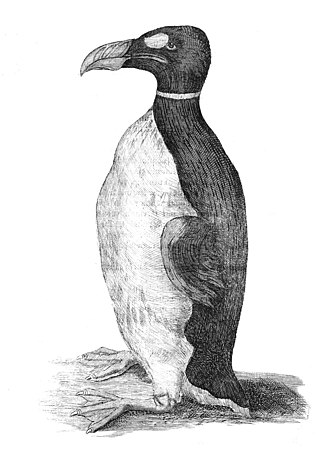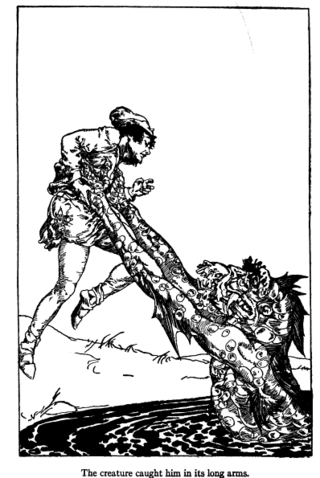Related Research Articles

Aos sí is the Irish name for a supernatural race in Celtic mythology – daoine sìth in Scottish Gaelic – comparable to fairies or elves. They are said to descend from the Tuatha Dé Danann, meaning the "People of Danu", depending on the Abrahamic or pagan tradition.

In Gaelic myth, the Cailleach is a divine hag and ancestor, associated with the creation of the landscape and with the weather, especially storms and winter. The word literally means 'old woman, hag', and is found with this meaning in modern Irish and Scottish Gaelic, and has been applied to numerous mythological and folkloric figures in Ireland, Scotland, and the Isle of Man. In modern Irish folklore studies, she is sometimes known as The Hag of Beara, while in Scotland she is known as Beira, Queen of Winter.

A kelpie, or water kelpie, is a shape-shifting spirit inhabiting lochs in Irish and Scottish folklore. It is usually described as a black horse-like creature, able to adopt human form. Some accounts state that the kelpie retains its hooves when appearing as a human, leading to its association with the Christian idea of Satan as alluded to by Robert Burns in his 1786 poem "Address to the Devil".
Fairies, particularly those of Irish, English, Scottish and Welsh folklore, have been classified in a variety of ways. Classifications – which most often come from scholarly analysis, and may not always accurately reflect local traditions – typically focus on behavior or physical characteristics.

The boobrie is a mythological shapeshifting entity inhabiting the lochs of the west coast of Scotland. It commonly adopts the appearance of a gigantic water bird resembling a cormorant or great northern diver, but it can also materialise in the form of various other mythological creatures such as a water bull.

Irish folklore refers to the folktales, balladry, music, dance, and so forth, ultimately, all of folk culture.

The nuckelavee or nuckalavee is a horse-like demon from Orcadian folklore that combines equine and human elements. British folklorist Katharine Briggs called it "the nastiest" of all the demons of Scotland's Northern Isles. The nuckelavee's breath was thought to wilt crops and sicken livestock, and the creature was held responsible for droughts and epidemics on land despite being predominantly a sea-dweller.

A fuath is a class of malevolent spirits in Scottish Highland folklore, especially water spirits.
The baobhan sith is a female fairy in the folklore of the Scottish Highlands, though they also share certain characteristics in common with the succubus. They appear as beautiful women who seduce their victims before attacking them and killing them.
The bean-nighe is a female spirit in Scottish folklore, regarded as an omen of death and a messenger from the Otherworld. She is a type of ban-sìth that haunts desolate streams and washes the clothing of those who are about to die. Les Lavandières is the French word under which these "night washerwomen" are perhaps best known. She is also called nigheag, 'the little washer', nigheag na h-ath, 'little washer of the ford', or nigheag bheag a bhroin, 'little washer of the sorrow'.
The cù-sìth(e), plural coin-shìth(e) is a mythical hound found in Irish folklore and Scottish folklore. In Irish folklore it is spelled cú sídhe, and it also bears some resemblance to the Welsh Cŵn Annwn.

Gillie or ghillie is an ancient Gaelic term for a person who acts as a servant or attendant on a fishing, hunting, deer stalking or hawking expedition, primarily in the Scottish Highlands or on a river such as the River Spey. In origin it referred especially to someone who attended on his male employer or guests.
The wulver or wullver is a kind of wolf-like humanoid creature in the folklore of the Shetland Islands of Scotland. In modern times, the origin of the wulver has been disputed.
The glaistig is a ghost from Scottish mythology, a type of fuath. It is also known as maighdean uaine, and may appear as a woman of beauty or monstrous mien, as a half-woman and half-goat similar to a faun or satyr, or in the shape of a goat. The lower goat half of her hybrid form is usually disguised by a long, flowing green robe or dress, and the woman often appears grey with long yellow hair. A sighting of the glaistig is rare, but the loud cries and wails would often be heard.
The caoineag is a female spirit in Scottish folklore and a type of Highland banshee, her name meaning "weeper". She is normally invisible and foretells death in her clan by lamenting in the night at a waterfall, stream or Loch, or in a glen or on a mountainside. Unlike the related death portent known as the bean nighe, the caoineag cannot be approached, questioned, or made to grant wishes.
The bauchan is a type of domestic hobgoblin in Scottish folklore. It is often mischievous and sometimes dangerous, but is also very helpful when the need arises.
The water bull, also known as tarbh-uisge in Scottish Gaelic, is a mythological Scottish creature similar to the Manx tarroo ushtey. Generally regarded as a nocturnal resident of moorland lochs, it is usually more amiable than its equine counterpart the water horse, but has similar amphibious and shapeshifting abilities.

The blue men of the Minch, also known as storm kelpies, are mythological creatures inhabiting the stretch of water between the northern Outer Hebrides and mainland Scotland, looking for sailors to drown and stricken boats to sink. They appear to be localised to the Minch and surrounding areas to the north and as far east as Wick, unknown in other parts of Scotland and without counterparts in the rest of the world.
In Scottish folklore, the beithir is a large snakelike creature or dragon.
In Scottish folklore the Biasd Bheulach is a monster or spirit that haunts Odal Pass on the Isle of Skye in Scotland. It is also known as the Biasd Bealach Odail.
References
Citations
- ↑ David Amerland (2017), The Sniper Mind: Eliminate Fear, Deal with Uncertainty, and Make Better Decisions, St. Martin's Press, p. 53, ISBN 978-1-250-11368-9
- ↑ MacKillop, James (2004), "ghillie", A Dictionary of Celtic Mythology (online ed.), Oxford University Press, retrieved 12 September 2014
- ↑ Dwelly (1902), p. 492
- ↑ Dwelly (1902), p. 367
- 1 2 3 Briggs (2002), p. 49
- ↑ Briggs (1961), p. 517
- ↑ Mackenzie (1921), p. 233
- ↑ Briggs (2002), p. 284
- 1 2 3 4 5 6 7 8 9 Mackenzie (1921), p. 234
- ↑ MacKillop, James (2004), "gille dubh", A Dictionary of Celtic Mythology (online ed.), Oxford University Press, retrieved 13 September 2014
- ↑ Dixon (1886), p. 334
- 1 2 Monaghan (2009), p. 214
- 1 2 Silver (2000), p. 120
- ↑ Rabuzzi (1984), p. 74
- ↑ Mackenzie (1921), p. 235
- ↑ Black (2005), p. liv
- ↑ Eberly (1988), p. 72
- ↑ Strange and Secret Peoples, Oxford University Press, archived from the original on 7 March 2016, retrieved 15 September 2014
- ↑ Black (2005), p. liii
Bibliography
- Black, Ronald (2005), "Introduction", The Gaelic Otherworld: John Gregorson Campbell's Superstitions of the Highlands and Islands of Scotland and Witchcraft and Second Sight in the Highlands and Islands, Birlinn[ dead link ]
- Briggs, Katharine Mary (1961), "Some Late Accounts of the Fairies", Folklore, Taylor and Francis, 72 (3), JSTOR 1258579
- Briggs, Katharine Mary (2002) [1967], The Fairies in Tradition and Literature, Psychology Press, ISBN 978-0-415-28601-5
- Dixon, John H. (1886), Gairloch in North-west Ross-shire, Edinburgh Co-operative Printing
- Dwelly, Edward (1902), Faclair Gàidhlìg air son nan sgoiltean, vol. 2, E. MacDonald
- Eberly, Susan Schoon (1988), "Fairies and the Folklore of Disability: Changelings, Hybrids and the Solitary Fairy", Folklore, Taylor and Francis, 99 (1), JSTOR 1259568
- Mackenzie, Osgood Hanbury (1921), A Hundred Years in the Highlands, Edward Arnold
- Monaghan, Patricia (2009), The Encyclopedia of Celtic Mythology and Folklore, Infobase Publishing, ISBN 978-1-4381-1037-0
- Rabuzzi, Daniel Allen (1984), "In Pursuit of Norfolk's Hyter Sprites", Folklore, Taylor and Francis, 95 (1), JSTOR 1259761
- Silver, Carole G. (2000), Strange and Secret Peoples: Fairies and Victorian Consciousness, Oxford University Press[ dead link ]